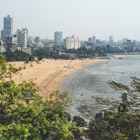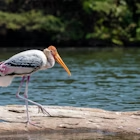
A first-timerвҖҷs guide to IndiaвҖҷs Andaman Islands

Oct 29, 2019 вҖў 7 min read

India's Andaman Islands retain something of a mystical air. Ephotocorp / Getty Images
Glittering salt-white beaches washed by teal shallows, swirls of ancient, often-impassable jungle, hot-pink sunrises over spindly coconut palms вҖ“ the Andaman Islands, scattered like pearls in the twinkling Andaman Sea, remain a tantalising mystery to most travellers.

Remote and still a challenge to reach, the dreamy Andamans lie geographically closer to Myanmar and Indonesia than the rest of India (1370km to the west), and are populated by both South and Southeast Asian settlers, and (sadly threatened) indigenous tribal communities. Together with the off-limits Nicobar Islands (south of the Andamans), the archipelago comprises 572 islands, with just a handful accessible to visitors. Those that do make the long journey here will find an alluring laid-back vibe, a compendium of IndiaвҖҷs best beaches and some of the finest diving and surfing in Asia.
Considering a visit? Covering everything from how to get there to where to stay, hereвҖҷs our guide to visiting the Andaman Islands for the first time.
How to get to the Andaman Islands
There are no international flights to the Andamans, so youвҖҷre looking at a domestic flight into Port Blair from mainland-India cities such as Chennai, Hyderabad, Mumbai, Delhi or Bengaluru. It's also possible to reach the islands via the original route: by sea. A few ferries rattle across the Bay of Bengal to Port Blair from Chennai, Kolkata and Visakhapatnam, though timings are unreliable and distances long.
The requirement for foreigners to have a Restricted Area Permit (RAP) to visit the Andamans was overturned in 2018. Now travellers can visit 29 inhabited and 11 uninhabited islands without permits, including Havelock Island, Neil Island, Long Island, North Andaman, South Andaman, Middle Andaman and Little Andaman (though always excluding tribal areas).
Best time to visit the Andaman Islands
December to March are the top months for warm, sunny weather, good transport links and the best diving conditions, and youвҖҷre also likely to spot turtles nesting on Middle and North Andaman. The shoulder months of October, November, April and May are less reliable weather-wise, though accommodation prices drop, crowds are down and thereвҖҷs consequently less strain on the natural environment.
An overview of each of the islands
Port Blair
EveryoneвҖҷs first (ahem) port of call is the bustling provincial capital Port Blair, on South Andaman. While in town sorting out travel arrangements, itвҖҷs worth exploring the chilling British-built 1906 Cellular Jail National Memorial, where political prisoners were once held, and the jungle-wreathed Victorian BritishвҖ“style ruins on Ross Island (Netaji Subhas Chandra Bose Dweep), the islandsвҖҷ colonial-era administrative headquarters until 1941. But the best of this region is out in the wild: the 280 sq km Mahatma Gandhi Marine National Park is a popular day trip from Port Blair (permit required).
Where to stay: Andaman Homestay, Port Vista and Lalaji Bay View are reliable budget-to-midrange picks. Towards the upper end, go for Fortune Resort Bay Island or Sinclairs Bayview, both with sea panoramas.
Havelock Island (Swaraj Dweep)
When people rave about the Andamans, theyвҖҷre often talking about dazzling Havelock Island, the most developed of the islands. Silky beaches backed by thick rainforest melt into sparkling turquoise water, and the diving and snorkelling here rival the very best in South Asia. Established operators such as Dive India, Ocean Tribe and Barefoot Scuba lead you through underwater depths to spot wrecks, sharks, rays, turtles, schools of snapper and more.
Post-diving, laze away your days catching the sunrise at Kalapathar, swimming at sheltered NeilвҖҷs Cove and strolling along fabulous Radhanagar, one of AsiaвҖҷs most spectacular beaches, before settling in for home-cooked Indian-international dinners, perhaps at Full Moon CafГ© or Anju-Coco Resto. For something more active, hike into the lushly forested interior and to Elephant Beach, or join a kayaking expedition through the mangroves.
Where to stay: Eco-conscious British-run Jalakara offers boutique seclusion, a seductive infinity pool and seven uniquely designed rooms amid betel-nut trees and banana palms. Just back from RadhanagarвҖҷs sands, ecofriendly island original Barefoot at Havelock has graceful bamboo, timber and tented cottages. Budget-friendly haunts include Emerald GeckoвҖҷs beachside huts; Flying Elephant, with its bungalows overlooking electric-green rice paddies; and backpacker favourite Green Imperial. Most dive schools have simple accommodation.

Neil Island (Shaheed Dweep)
A few notches down in busyness from its sister Havelock just north across the water, Neil Island is a delightfully easy-going, pancake-flat world of rice fields, palm trees, rocky beaches, a small bazaar and a sleepy jetty that leaps into action when ferries arrive. Budget travellers head here for the rustic beach-hut vibe that originally lured people to Havelock (though mainstream tourism is on the rise on Neil, too). While NeilвҖҷs beaches arenвҖҷt fantastic for swimming, thereвҖҷs excellent diving courtesy of pioneering schools like India Scuba Explorers and Dive India (you might even spot a dugong!).
Where to stay: Fuss-free bungalows such as Emerald Gecko, Breakwater Beach Resort and Kalapani epitomise all thatвҖҷs wonderful and laid-back about Neil. Waterside SeaShell is arguably the islandвҖҷs most upmarket stay.
Little Andaman
The kind of deliciously isolated place mentioned in hushed whispers among enamoured travellers, Little Andaman is the southernmost island that it's possible to visit in the Andamans. It's bordered by powder-soft, sun-dusted white beaches, tangles of mangroves and tumbling teal waves that make for some of IndiaвҖҷs most terrific surf, especially at sweeping Butler Bay and from February to April. Around 130km south of Port Blair, Little Andaman suffered serious casualties during the 2004 tsunami, but has since bounced back and now ranks among the most enticing destinations in the Andamans. Around 25 sq km of the island is a protected, off-limits tribal reserve for the indigenous Onge people.
Where to stay: Most accommodation is of the budget beach cottage genre; try Hawva Beach Resort or Ieshika Resort, just back from Netaji Nagar beach. Many guest houses rent surfboards.
Middle & North Andaman
Few travellers tackle the long journey north from Port Blair to Middle and North Andaman, but venture here and youвҖҷll uncover outstanding snorkelling, pristine honey-gold beaches, impenetrable primeval jungle, a world-renowned turtle-nesting site, a string of eerie limestone caves, a smattering of serene offshore islets, and much more.
Kalipur beach (just outside the AndamansвҖҷ second-largest settlement, Diglipur, in far North Andaman) is believed to be the only place in the world where leatherback, hawksbill, olive ridley and green turtles nest on the same coastal stretch (mid-December to March or April). There is simple accommodation at Kalipur, from where hikes up the AndamansвҖҷ highest mountain, 732m-tall Saddle Peak, can also be arranged.
In the remote area around Mayabunder, on Middle Andaman, you can stay amid glinting rice fields with a local conservationist family at self-sufficient Ko Hee Homestay, heading out on wildlife-spotting treks and learning about traditional crafts. Or get away from it all with a spell on quiet, untouristed Long Island, just off Middle Andaman, where bamboo-clad Blue Planet is the only place to stay.
Getting around
Once youвҖҷve made it to Port Blair, the only way to reach most of the other islands is by ferry. Government ferry tickets are released just three days ahead (it can be a scramble at ticket offices!); tickets arenвҖҷt available online and youвҖҷll need to ask locally for schedules (thereвҖҷs an information office at Port BlairвҖҷs Phoenix Bay Jetty). Buses trundle north from Port Blair through Middle Andaman and on to Diglipur on North Andaman вҖ“ cheap, though time-consuming!
Thankfully, Havelock and Neil are also linked to Port Blair and each other by private ferries operated by Makruzz, Green Ocean, and ; these usually open for bookings (including online) at least a month ahead, making them the easiest option for travellers. On most islands, hiring your own bicycle or motorbike is the best way to explore.
Visiting the islands responsibly
The AndamansвҖҷ fragile ecosystems and small, isolated communities remain seriously at risk from tourism (and other) development. Divers and snorkellers can help by choosing environmentally responsible operators, ensuring reefs arenвҖҷt damaged (by flippers, or by touching marine life etc), while more general practices include minimising single-use plastics, clearing any rubbish encountered, not removing shells from beaches, and supporting hotels, shops and restaurants committed to a green ethos. If youвҖҷre looking to donate your time, the NGO Reef Watch Marine Conservation accepts volunteers.
Meanwhile, for both safety and dignity, the islandsвҖҷ indigenous tribal communities live in regions off-limits to visitors. Heartbreakingly, many groups have become extinct in the last century, and there are serious repercussions for anyone caught trying to access these restricted areas.
ItвҖҷs also worth noting there have been several fatal crocodile attacks in the Andamans in recent years: check locally as to where itвҖҷs safe to swim and keep out of the water at dawn and dusk.
Explore related stories






 Sustainable TravelTalkinвҖҷ trash: 6 beach cleans you can join in cities around the world
Sustainable TravelTalkinвҖҷ trash: 6 beach cleans you can join in cities around the worldOct 16, 2019 вҖў 7 min read



